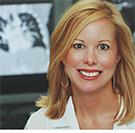Radiology Article Awarded “Minnies” Scientific Paper of the Year
Jennifer Kemp, MD, and colleagues elevate the dialogue on patient-centered radiology

The June 2017 Radiology article, “Patient-centered radiology: Where are we, where do we want to be, and how do we get there?” has received the 2017 Minnies Award for Scientific Paper of the Year in the annual event sponsored by AuntMinnie.com.
Lead author Jennifer L. Kemp, MD, from Diversified Radiology in Denver, and colleagues, presented the results from a 2015 survey by the RSNA Patient-Centered Radiology Steering Committee, which sought to obtain a better understanding of the state of patient-centered care within the radiology community. Dr. Kemp is a member of the RSNA Public Information Advisors Network and the Public Information Committee.
U.S.-based RSNA members were surveyed about their general attitudes and experiences concerning patient-centered radiology, with specific attention paid to radiologist-to-patient communication and possible barriers to such interaction.
While many radiologists said they would receive personal satisfaction from communicating directly with patients, time or workload frequently prevented them from doing so, the results showed.
The authors concluded that the focus on patient-centered care will continue due to its potential to enhance the patient experience throughout the continuum of care. They suggested small steps that could help radiologists connect with patients, such as engaging them through social media or having reading rooms intermixed with clinical areas to foster more interaction with patients and referring physicians.
“Patient-centered radiology is a lot more than giving results to patients,” Dr. Kemp said. “The key takeaways here are that radiologists are in agreement that patient-centered care is always our goal and that our efforts should continue to focus on how best to achieve that goal.”
First launched in 2000, the Minnies give radiology professionals the opportunity to highlight the contributions of their peers to the advancement of medical imaging.

Web Extras
- Access the study, “Patient-centered radiology: Where are we, where do we want to be, and how do we get there?” at http://pubs.rsna.org/doi/full/10.1148/radiol.2017162056